by
Michael D. Meyer, Ph.D., P.E.
School of Civil and Environmental Engineering
Georgia Institute of Technology
Information Technologies and Influence
virtual communities
cyber cities
cyberopolis
infocities
telecommunities
network cities
digital places
Virtual communities that networks bring together are often defined by common interests rather than by common location...the story of virtual communities so far, is urban history replayed in fast forward...but with computer resource use playing the part of land use, and network navigation systems standing in for streets and transportation systems...as more and more business and social interactions shift into cyberspace, we are finding that accessibility depends even less on propinquity, and community has come increasingly unglued from geography.
[Mitchell, 1999]
The old demarcation between work and home will evaporate...in its place will be a shift in the location of work, a new role for cities, a new role for the home, and reshaped communities...In half a century's time, it may well seem extraordinary that millions of people once trooped from one building (their home) to another (their office) each morning, only to reverse the procedure each evening...All this might strike our grandchildren as bizarre.
[Cairncross, 1996]
10 U.S. Cities Most Likely to Benefit From the Internet (Stephen Roulac, 2000)
New York, San Jose, San Francisco, Los Angeles, Boston, Seattle, Atlanta, Chicago, Miami and D.C.
Why?
"these cities are able to attract the talent"
"sense of place, beauty in the natural environment, transportation system, 24-hour city with mixed uses/mixed activity/diversity"
Sommers and Carlson, The Brookings Institution
"Ten Steps to a High Tech Future"
Location decisions for high tech players varied by sector
High tech manufacturers: suburban industrial parks due to cost factors and future expansion
New telecommunications, internet content, and e-commerce companies: downtown locations for the "infrastructure" and competitive advantage in hiring talent
Biotechnology firms: near research institutions and hospitals
Ten Steps to a High Tech Future
Hal Cohen
"Like anything else, high tech requires infrastructure, and like any infrastructure, the new tends to go right where the old was as economic logic says to minimize risk by investing in already dominant areas...new telecom infrastructure like fiber optic is run between the same important info hubs that already dominate via copper connections, often on rights-of-way of even older infrastructure such as railroads and highways, reinforcing those networks' traditional, city-centric organization of space."
Mitchell Moss
"The future is much more like Silicon Valley or San Francisco where firms engaged in the same activities thrive by being next to each other, where they can access each other's products and labor forces."
This implies that enhancing the transportation system as part of a metropolitan strategy to improve quality of life and promote the livability of urban places directly fits into a strategy of encouraging e-commerce and high tech development
SMART GROWTH (ITE SPECIAL ISSUE)
What about business transportation?
Five major economic trends have affected the nature of business transportation requirements:
Average Daily Number of Trips by Vehicle Type
| Vehicle Type |
N |
Mean |
| Light-Duty Trucks |
991,233 |
4.99 |
| Medium-Duty Trucks |
91,060 |
9.96 |
| Heavy-Duty Trucks |
231,112 |
4.83 |
Base: All trips, including vehicles that made no trips on travel day (weighted).
Comparison of Weighted Daily Truck Trips.
| City |
Mean |
| Atlanta |
6.88
|
| San Antonio, TX |
8.27 |
| Phoenix, AZ |
7.70 |
| Winston-Salem / High Point / Greensboro, NC |
7.40 |
Commercial Trips by Land Use Destination
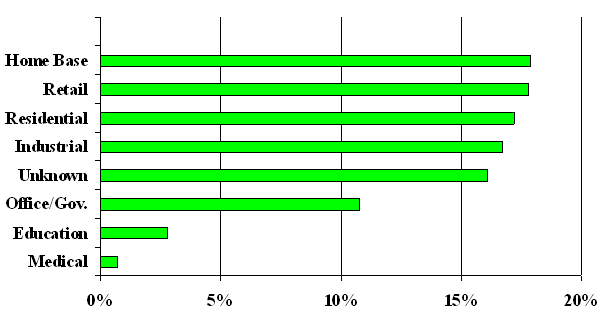
Average Total Daily Mileage by Commercial Vehicle Type
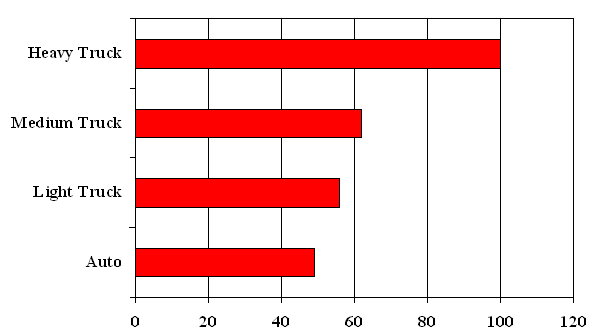
Average Trip Length (miles) by Commercial Vehicle Type
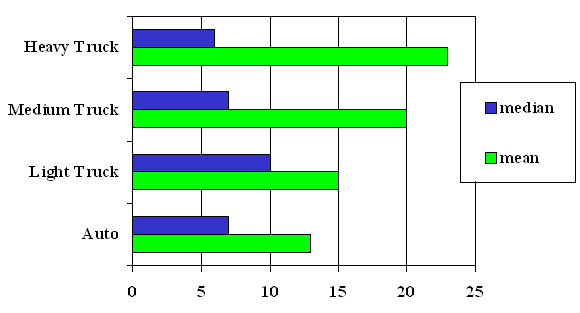
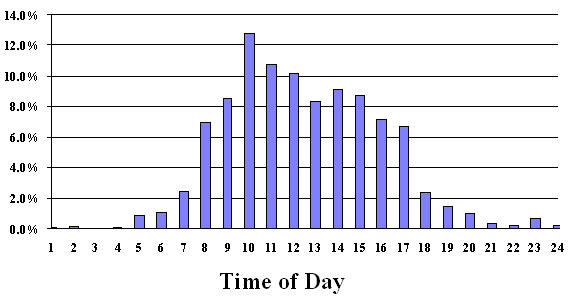
E-business and freight movement
Important Emerging Issues
Examples
Brownfield intermodal freight infrastructure in northern New Jersey
Global freight village
Commuter rail package dropoff
New warehousing next to international airport
Package delivery distribution/collection facility within one block of rail intermodal facility
Truck-only facilities
Curb management strategies
Conclusions
The transportation system plays an important part in "completing the transaction."
Terminal capacity, location and operations that allow integrated product movements across modes are critical business decisions in providing the most cost efficient delivery of services.
Proximity of e-commerce activities suggests an important supporting role for good transportation
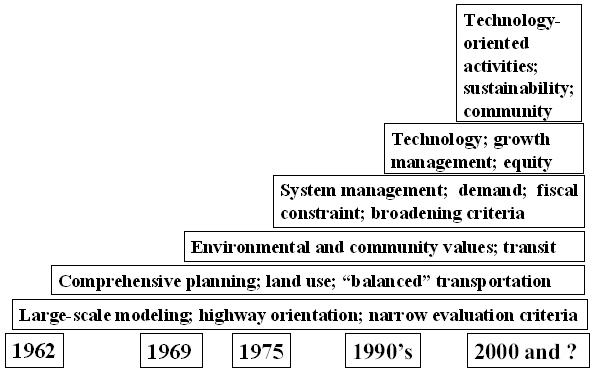
Transportation Planning Issues Over Time